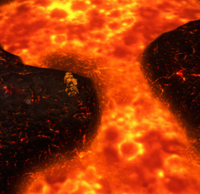Stars and planets
From the Dyson Sphere Program Wiki
More actions
This article is a stub.
This article needs some ❤️! You can help the Dyson Sphere Program Wiki by expanding it. See Category:Article stubs for other pages that needs expansion.
This article is a work in progress.
This article is in the process of an expansion or major restructuring.! You are welcome to assist in its construction by editing it as well. See Category:Work in progress for other pages that needs expansion.
Summary
There are many types of stars and planets, each of which has their own advantage, and disatvantages in terms of gameplay value. This page is dedicated to catergorize all astronomical ojects and phenomenas, and describe them.
When picking a star to construct a dyson sphere around, it's highly reccomended to do it around a star with the highest luminosity (L☉), as many stars can have more than double (~2 L☉) if not triple (~3 L☉) the energy output than the starter system's star (~1 L☉), which is much less time consuming, and more effective than building one or even two additional dyson spheres orbiting neighbouring stars.
Types of planets
| Name | Description | Image | Surface view |
|---|---|---|---|
| Mediterranean planet | Lush, tropical, and covered with oceans, they're abundant with basic ressources, this is the type of planet the player starts on. They're also a great source of crude oil. | ||
| Lava planet | Inhospitable, covered with lava lakes, they usually contain silicon ore and titanium ore. |  |
 |
| Ice giant | One of the two versions the starter planet will orbit, they contain hydrogen and is a great source of Fire_Ice, material that is used to craft graphene. | ||
| Barren planet | Similar to the moon, its surface is covered with craters, since there's no atmosphere, wind turbines are useless, there are no oceans either, but it has the biggest construction area, and can be a decent source for soil piles. | ||
| Prairie planet | Similar to mediterranean planets, they're habitable lush oceanic planets, has less oceans, and more grasslands. They're also a good source of crude oil. Organic crystal veins can also be found there. | ||
| Gobi desert planet | Another planet fully devoid of any life or water, but does contain mountains, so they're a great source for soil piles. | ||
| Ashen gelisol planet | Similar to a gobi desert planet, it's fully devoid of anything, but this time a frozen one. | ||
| Volcanic ash planet | Similar to a lava planet, it's devoid of anything but volcanic activity, however, these planets are also a great source of sulfuric acid, and oceans of such are found around such planets. | ||
| Arid desert | Another desert planet, but compared to others, these planets are a great source for capturing wind energy. | ||
| Ice planet | Planets covered with ice, and may have pockets of water scattered around the surface, veins of fire ice can be found around such planets. Since they're usually far away from their orbiting star, and have no atmosphere, they're terrible sources for renewable energy, the use of thermal power stations is reccomended. | ||
| Oceanic jungle planet | Similar to mediterranean and prairie planets, they're lush planets, and they commonly contain sources of spiniform stalagmite crystals, crude oil, and organic crystals. | ||
| Oceanic planet | almost entirelly covered with oceans, it's very impractical to construct any infrastructure on it. It's another source of spiniform stalagmite crystals, but it's highly reccomended you bring foundations and plenty of soil piles before you have anything to do with such planets. | ||
| Red mushroom planet | Similar to mediterranean planets, but the soil is more reddish, and the surface is covered with mushrooms. | ||
State of stellar objects
Planets can have multiple physical attributes and states, which are listed below.
| Name | Description | Image |
|---|---|---|
| Tidal locking (TL) | Planets that has the same rotational period as orbital period, and consequently has one side permanently facing its host star or planet. Very useful to capture the host star's energy via solar panels and/or ray receivers | |
| Sattelite (SAT) | Astronomical objects that orbit another object that isn't a star, or in simpler terms, a moon. The starter planet is one example of such object. However, building EM-rail ejectors would be problematic, as the orbiting parent can block the sun, rendering them useless until the orbiting object passes, this decreases the time the EM-rail ejectors can fire sails, and decreases their effeciency. | |
| Reverse Rotation (RR) | The astronomical object in question rotates in the reverse direction, or clockwise when viewed from one of the poles. |
Stellar objects
| Name | Description | Image |
|---|---|---|
| Class M star | The most abundant class of star is M, however, its luminosity is very low, making it very impractical to construct dyson spheres around them. | Example |
| Class K star | ||
| Class G star | ||
| Class F star | ||
| Class A star | ||
| Class B star | ||
| Class O star | The brightest star type, ideal for constructing dyson spheres around them | |
| Neutron star | One of the rarest stars, unipolar magnets are commonly found on host planets orbiting such stars. | |
| White dwarf | ||
| Black hole | A dead star, it's the only other source of unipolar magnets aside from neutron stars. |

